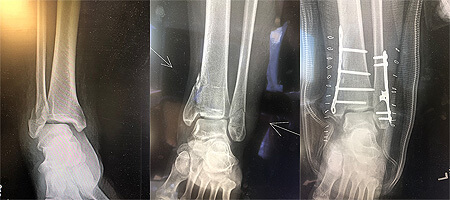Ankle Fractures in a Nutshell
Thursday, 04 October 2018 19:55 If you have experienced a breaking of any of the bones that make up the ankle joint, which is referred to as an ankle fracture, you may be aware that there can be significant pain as well. The bones that make up the ankle joint are the tibia, fibula, and talus bones. There are many reasons an ankle injury can occur, such as twisting your ankle inwards or outwards, falling, a crush injury, or a motor vehicle accident. An ankle fracture can also occur due to sports injury, repetitive stress, or as a consequence to nerve problems of the feet and legs.
If you have experienced a breaking of any of the bones that make up the ankle joint, which is referred to as an ankle fracture, you may be aware that there can be significant pain as well. The bones that make up the ankle joint are the tibia, fibula, and talus bones. There are many reasons an ankle injury can occur, such as twisting your ankle inwards or outwards, falling, a crush injury, or a motor vehicle accident. An ankle fracture can also occur due to sports injury, repetitive stress, or as a consequence to nerve problems of the feet and legs.
The symptoms of a broken ankle are pain, swelling, bruising, numbness, throbbing, and difficulty putting weight down on the foot. In more severe cases, there may be a deformity, which may represent a dislocation where the foot can actually separate from the ankle. If you have had an ankle injury, it is important that you consult with your podiatric surgeon so you can start the best course of treatment immediately. If you have any concerns regarding you ankle, contact Dr. Lee R. Stein from Lake Shore Foot & Ankle. Our doctor will treat your foot and ankle needs
Ankle fractures are usually diagnosed with a proper history, as well as x-rays. For proper evaluation, it may be necessary for the doctor to order a CT or MRI scan.
A broken ankle can lead to complications and can occasionally cause long standing deformity or severe pain if not treated properly. In certain cases, a splint, cast, or boot may be the preferred treatment, along with rest, ice, and elevation depending on the fracture type. In other cases, surgery may be necessary, which may involve open reduction internal fixation (ORIF) with screws and/or plate hardware or the use of external fixation (frame around skin). At LSFA we use the latest in biologic techniques to achieve efficient healing with amniotic tissue, bone marrow aspirate, bone stimulation, shockwave, and laser.
By Lee R. Stein, DPM, FACFAS, FACLES, FAENS
Blog Archives
- May 2025
- April 2025
- March 2025
- February 2025
- January 2025
- December 2024
- November 2024
- October 2024
- September 2024
- August 2024
- July 2024
- June 2024
- May 2024
- April 2024
- March 2024
- February 2024
- January 2024
- December 2023
- November 2023
- October 2023
- September 2023
- August 2023
- July 2023
- June 2023
- May 2023
- April 2023
- March 2023
- February 2023
- January 2023
- December 2022
- November 2022
- October 2022
- September 2022
- August 2022
- July 2022
- June 2022
- May 2022
- April 2022
- March 2022
- February 2022
- January 2022
- December 2021
- November 2021
- October 2021
- September 2021
- August 2021
- July 2021
- June 2021
- May 2021
- April 2021
- March 2021
- February 2021
- January 2021
- December 2020
- November 2020
- October 2020
- September 2020
- August 2020
- July 2020
- June 2020
- May 2020
- April 2020
- March 2020
- February 2020
- January 2020
- December 2019
- November 2019
- October 2019
- September 2019
- August 2019
- July 2019
- June 2019
- May 2019
- April 2019
- March 2019
- February 2019
- January 2019
- December 2018
- November 2018
- October 2018
- September 2018
- August 2018
- July 2018







